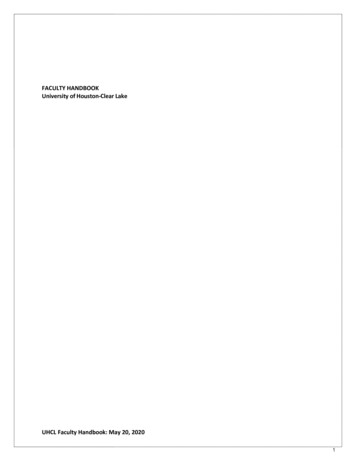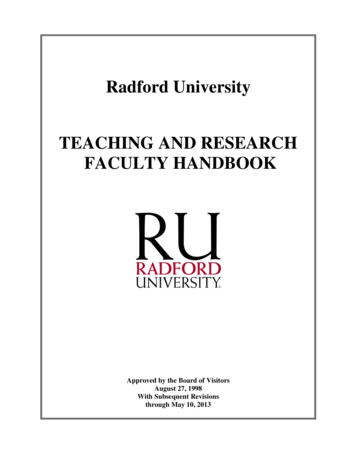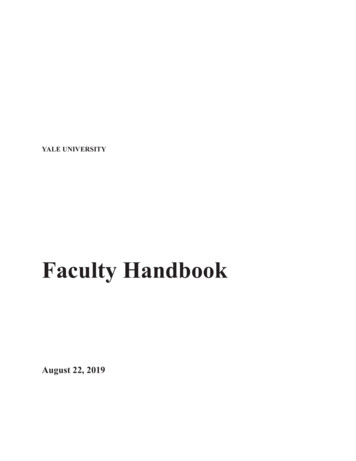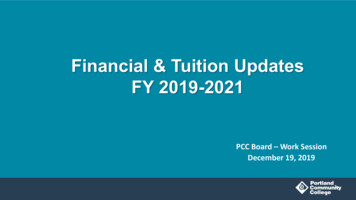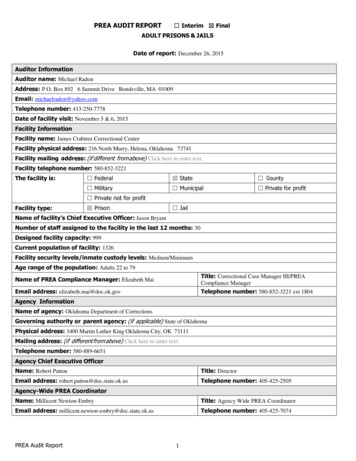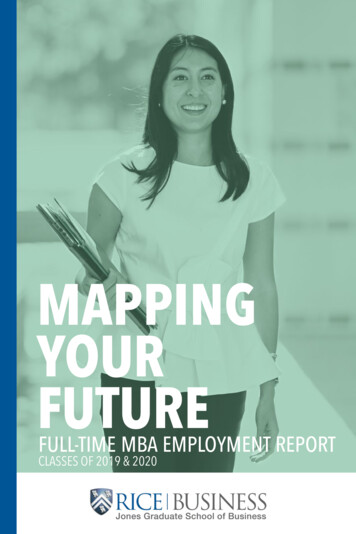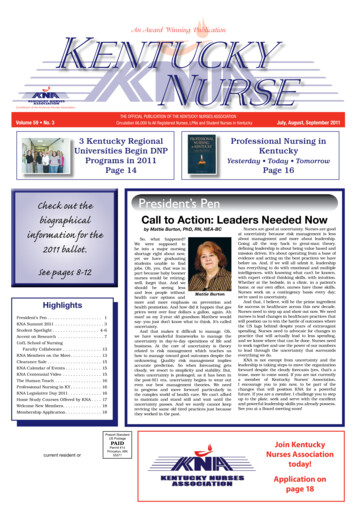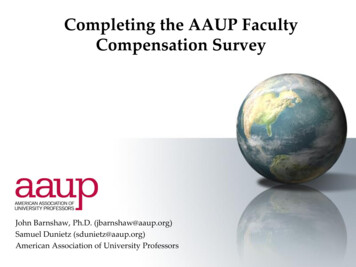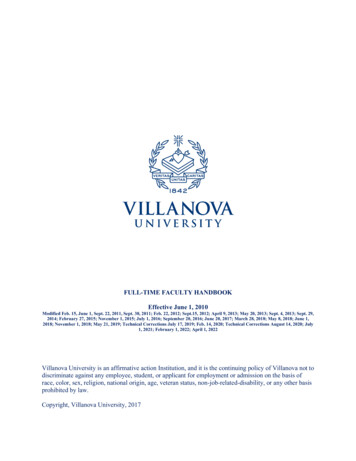
Transcription
FULL-TIME FACULTY HANDBOOKEffective June 1, 2010Modified Feb. 15, June 1, Sept. 22, 2011, Sept. 30, 2011; Feb. 22, 2012; Sept.15, 2012; April 9, 2013; May 20, 2013; Sept. 4, 2013; Sept. 29,2014; February 27, 2015; November 1, 2015; July 1, 2016; September 20, 2016; June 20, 2017; March 28, 2018; May 8, 2018; June 1,2018; November 1, 2018; May 21, 2019; Technical Corrections July 17, 2019; Feb. 14, 2020; Technical Corrections August 14, 2020; July1, 2021; February 1, 2022; April 1, 2022Villanova University is an affirmative action Institution, and it is the continuing policy of Villanova not todiscriminate against any employee, student, or applicant for employment or admission on the basis ofrace, color, sex, religion, national origin, age, veteran status, non-job-related-disability, or any other basisprohibited by law.Copyright, Villanova University, 2017
INTRODUCTIONVillanova’s faculty constitutes the foundation of the University’s academic enterprise. Villanova takespride in the excellence and dedication of its faculty, and it relies on the faculty, together withadministrators and staff, to carry out its educational mission. In its essential functions 1, the facultyprovides expertise, judgment, creativity, and leadership in academic matters. The Universityadministration bears the legal authority and responsibility for the University and its operations, asdelegated by the Trustees, and it provides strategic and administrative leadership, support, oversight, andmanagement for academic matters. Through shared governance and collegiality, faculty, administrators,and staff are partners in advancing the University’s mission. Together, we work toward Veritas, Unitas,and Caritas.After providing an overview of the University’s mission and structure, this Handbook describes theposition of the faculty in the University. The product of years of cooperation between the Office of theProvost and the Faculty Rights and Responsibilities Committee, the Faculty Congress, and the AcademicPolicy Committee, the Handbook seeks to provide clarity as to the structures, responsibilities, andbenefits of academic life at Villanova. In this sense, the Handbook is part of the University's contractwith faculty members. Because of legal and regulatory requirements in certain areas, owing to thecontractual nature of the employment agreement between the University and its faculty and in view ofobligations the University has to students and others, parts of the Handbook necessarily are couched inlegal terms and/or include specific requirements or prohibitions. The University recognizes and dependson the faculty’s professionalism and understands that members of the faculty act accordingly. Thus muchof this Handbook simply articulates good professional practice. In situations where common proceduresmust be followed, where legal or contractual requirements must be honored, or where guidance is needed,the Handbook provides clear statements regarding procedures and prudent actions.This Handbook is for faculty members in the Colleges of Liberal Arts and Sciences, Engineering andNursing, and the School of Business. Although a paper version will be kept accurate and up to date, theofficial version is found at ces.html. Please reporterrors or mistakes to the Office of the Provost. Faculty members who have questions about the policiesand their application should consult their department chairs or program directors in the College ofNursing,In order to retain necessary flexibility in the administration of policy and procedure, Villanova Universityreserves the right to revise or delete any of the provisions of this Handbook and to revise, reduce, oreliminate any policy or benefit described in this Handbook, with or without notice, as the Universitydeems appropriate. Such actions, unless mandated by legal or contractual requirements, merely technicalin nature, or driven by emergencies, will not be undertaken without prior consultation with the FacultyRights and Responsibilities Committee.1 See Section 5 of this Handbook.
TABLE OF CONTENTSPART ONE: INSTITUTIONAL DESCRIPTION AND MISSION .11.2.HISTORY AND MISSION . 1UNIVERSITY STRUCTURE . 3PART TWO: POLICIES AND PROCEDURES ON RECRUITMENT,APPOINTMENT, RANK, TENURE, AND EVALUATION.113.4.5.6.7.8.EMPLOYMENT AGREEMENTS . 11ACADEMIC CITIZENSHIP AND COMMUNITY. 20ESSENTIAL FACULTY FUNCTIONS . 20EVALUATION OF FACULTY (PERIODIC) . 20RANK AND TENURE POLICY . 21RECRUITMENT OF FACULTY . 21PART THREE: OTHER FACULTY POLICIES, PROCEDURES, ANDBENEFITS .42.43.44.ACADEMIC ADVISING, OFFICE HOURS, AND STUDENT ACCESS . 22ACADEMIC FREEDOM . 22ACADEMIC INTEGRITY. 23AWARDS FOR FACULTY MEMBERS . 27CLASS ATTENDANCE . 28COMMENCEMENT, CONVOCATIONS, AND SPECIAL EVENT . 31COMMUNICATIONS . 31COMPENSATION. 31COMPLAINTS ABOUT FACULTY . 33CONFIDENTIALITY OF STUDENT RECORDS . 33CONFLICT OF INTEREST . 36CONSULTING, OUTSIDE TEACHING, AND PROFESSIONAL WORK . 37CONTRACTS . 38CONVENTIONS AND PROFESSIONAL MEETINGS . 39COPYRIGHTS AND COURSEPACKS . 39COURSE AND CLASS REGULATIONS . 41COURSE AND TEACHER SURVEY (CATS) . 42DEANS: PROTOCOL FOR SELECTION OF ACADEMIC DEANS . 42DEANS: PROTOCOL FOR THE EVALUATION OF ACADEMIC DEANS . 43DEPARTMENT CHAIRS . 46DISABILITIES, FACULTY WITH . 53DISABILITIES, STUDENTS WITH . 53DISCIPLINE OF STUDENTS . 54DISCRIMINATION AND HARASSMENT POLICIES . 54DISMISSAL AND SUSPENSION PROCEDURE FOR FACULTY . 55EMERGENCIES AND DISASTERS. 58EVENTS AND SPEAKERS POLICY . 58EXAMINATIONS – SEE FINAL EXAMINATIONS AND GRADES AND ASSESSMENTS . 61EXPORT CONTROLS POLICY . 61FACULTY DATA. 64FACULTY ROLE IN GOVERNANCE . 65FINAL EXAMINATIONS AND THE FINAL WEEK OF CLASSES . 65GRADES AND ASSESSMENTS . 66GRIEVANCE POLICY FOR FACULTY MEMBERS . 69HANDBOOK REVISION . 71INTELLECTUAL PROPERTY POLICY . 72
NAL FACULTY . 82LANGUAGE USE: WRITTEN AND ORAL COMMUNICATIONS ON CAMPUS . 83LEAVE OF ABSENCE, FAMILY (PARENTAL/ADOPTION) LEAVE. 83LEAVE OF ABSENCE POLICY . 83NEW COURSES AND NEW ACADEMIC PROGRAMS, DEGREES, MAJORS, MINORS,CONCENTRATIONS . 84NON-SOLICITATION POLICY . 85PUBLICATIONS . 88PUBLIC RELATIONS . 88RELIGIOUS HOLIDAYS . 88RESEARCH, MISCONDUCT . 89RESEARCH SUBJECTS . 95RESEARCH SUPPORT PROGRAM . 96RETIREMENT: STEADY STATE PROGRAM . 97SABBATICAL LEAVE . 100SALE OF TEACHING MATERIALS WRITTEN BY FACULTY MEMBERS . 103SEXUAL MISCONDUCT . 104PERSONAL RELATIONSHIPS POLICY . 105SMOKING . 107SPONSORED RESEARCH . 107SPONSORED RESEARCH: FACULTY RELEASED TIME . 107STUDENT GRADE APPEALS AND COMPLAINTS ABOUT FACULTY . 107SUMMER TEACHING . 111SYLLABI . 111TEACHING LOAD, OVERLOAD, AND OUT-OF-LOAD TEACHING . 111TEACHING SUPPORT PROGRAM . 112TERMINATION OF FACULTY EMPLOYMENT DUE TO FINANCIAL EXIGENCY OR CLOSURE OFA COLLEGE, DEPARTMENT, OR PROGRAM . 112TRAVEL WITH OR TEACHING STUDENTS OFF CAMPUS . 115USE OF UNIVERSITY’S NAME AND TRADEMARK . 116VOTING IN DEPARTMENTAL MEETINGS . 119BENEFITS . 120
PART ONE: INSTITUTIONAL DESCRIPTION AND MISSION1.HISTORY AND MISSIONFor over a century and a half, Villanova University has been sponsored by the Order of St.Augustine, known as the Augustinians, one of the oldest religious teaching orders of the CatholicChurch. The first American foundation of the order within the present limits of the United Stateswas established in 1796 at old St. Augustine's Church in Philadelphia. Villanova University tracesits lineage from this foundation and from St. Augustine's Academy, which was opened inPhiladelphia in 1811.In January 1842, the Philadelphia Augustinians took possession of Belle Air, the country estate ofthe Revolutionary War officer and merchant John Rudolph. In accordance with the Old Catholiccustom, the new foundation was placed under the patronage of a saintly hero of the past. As patronof the new Institution, the Augustinians chose St. Thomas of Villanova, a 16th century SpanishBishop who was a distinguished Augustinian writer and educator. The school soon became knownas Villanova and gave its name to the surrounding countryside.Classes were opened in the old mansion house at Belle Air during the fall of 1843. On March 10,1848, the Governor of Pennsylvania, Francis R. Shunk, signed the Act of the Legislatureincorporating “The Augustinian College of Villanova in the State of Pennsylvania” and conferringon it the right to grant degrees in the Arts and Sciences.The Liberal Arts College took its first step toward university status in 1905 with the establishmentof what is now called the College of Engineering. The Science unit, inaugurated in 1915, is now anintegral part of the present College of Liberal Arts and Sciences. In 1918, what is presently knownas the College of Professional Studies came into being. The School of Business was founded in1922 (as the College of Commerce and Finance), the College of Nursing in 1953, and the School ofLaw in 1953.Villanova's development over the years into a complex institution of higher education receivedofficial sanction when, on November 10, 1953, pursuant to an act of the Legislature of theCommonwealth of Pennsylvania, its charter was amended to permit it to be designated VillanovaUniversity.The University’s mission statement provides a summary statement of Villanova’s institutionalvalues and aspirations that set the overall tone of the University’s collective objectives.MISSION STATEMENTVillanova University is a Catholic Augustinian community of higher education, committed toexcellence and distinction in the discovery, dissemination and application of knowledge. Inspiredby the life and teaching of Jesus Christ, the University is grounded in the wisdom of the Catholicintellectual tradition and advances a deeper understanding of the relationship between faith andreason. Villanova emphasizes and celebrates the liberal arts and sciences as foundational to allacademic programs. The University community welcomes and respects members of all faiths whoseek to nurture a concern for the common good and who share an enthusiasm for the challenge ofresponsible and productive citizenship in order to build a just and peaceful world.1
Enduring CommitmentsIn pursuit of this mission, we commit ourselves to academic excellence, to our values andtraditions, and to our students, alumni and the global community.To foster academic excellence, we as a University: Create a diverse community of scholars, united and dedicated to the highest academicstandards;Emphasize the liberal arts and sciences as our foundation and foster in our students activeengagement, critical thinking, life-long learning and moral reflection;Concern ourselves with developing and nurturing the whole person, allowing students,faculty and staff to grow intellectually, emotionally, spiritually, culturally, socially andphysically in an environment that supports individual differences and insists that mutual loveand respect should animate every aspect of university life;Encourage interdisciplinary research, teaching and scholarship;Affirm the intrinsic good of learning, contemplation and the search for truth inundergraduate and graduate education;Support a curriculum that encourages both a global perspective and an informed respect forthe differences among peoples and cultures.To honor our values and tradition, we as a Catholic University: Believe that the dialogue between faith and reason drives the pursuit of knowledge andwisdom, and fosters St. Augustine’s vision of learning as a community ethos governed bylove;Seek to understand, enrich and teach the Catholic intellectual tradition through our curricula,scholarship and activities in ways that engage diverse religious, intellectual and culturaltraditions in a vigorous and respectful pursuit of truth and wisdom in every area ofhumanity;Provide opportunities for students, faculty and staff to seek guidance from Catholicintellectual and moral traditions, while always welcoming people from all faiths, culturesand traditions to contribute their gifts and talents to our mission;Respect and encourage the freedom proposed by St Augustine, which makes civil discussionand inquiry possible and productive;Look to the Order of St. Augustine to preserve our Augustinian character, by showingappropriate preference to Augustinians in faculty and staff appointments, and by welcomingtheir presence and influence in our university community.To serve our students, alumni and global community, we as an Augustinian University: Encourage students, faculty and staff to engage in service experiences and research, bothlocally and globally, so they learn from others, provide public service to the community andhelp create a more sustainable world;Commit to the common good, and apply the knowledge and skills of our studentsand faculty to better the human condition;Encourage our students and faculty to pursue virtue by integrating love andknowledge, and by committing themselves to research and education for justice,with a special concern for the poor and compassion for the suffering;2
2.Respect a worldview that recognizes that all creation is sacred and that fostersresponsible stewardship of the environment;Include our alumni as an integral part of the Villanova community;Value highly our relationship with neighboring communities.UNIVERSITY STRUCTUREPRESIDENT AND BOARD OF TRUSTEESFull legal jurisdiction in all that pertains to the University is vested in the Board of Trustees, whichis comprised of no fewer than twenty and no more than thirty-five members. Of these, no fewerthan nine are to be members in good standing of the Order of Saint Augustine. The President ofthe University is ex officio a member of the Board.The President is responsible to the Board as the executive head of the University and is responsiblefor the general direction of its affairs. The President performs all such duties as are provided for inthe By-Laws of the Board of Trustees, those assigned by the Board of Trustees, and those whichare necessary and proper for the performance of the office. As appropriate, the President delegatescertain authority to the Provost and Vice Presidents.The President, Provost and Vice Presidents serve at the discretion of the Board. All otheradministrative officers serve at the discretion of the President.OFFICE OF THE PRESIDENTThe University’s Executive Council consist of the President, the Provost, the Executive VicePresident, the Vice President for Finance, and the Senior Vice President for UniversityAdvancement. The council’s purpose is to ensure continued strategic, focused and streamlinedoversight of the University. This council provides critical leadership for the institution whileenabling the President to focus more heavily on strengthening Villanova's external reputation,development initiatives and overall global presence. The Executive Council will work directly withthe President's Cabinet, which will continue to serve as my leadership advisory group.The President’s Cabinet consist of the following officers:ProvostExecutive Vice PresidentSenior Vice President for University AdvancementVice President for Mission and MinistryVice President for University Communication & MarketingVice President and Chief Information OfficerVice President for Finance and Chief Financial OfficerVice President and Director of AthleticsVice President for Facilities ManagementVice President for Diversity and Inclusion and Chief Diversity OfficerVice President for Student LifeSenior Vice Provost for AcademicsVice President and General Counsel3
The Provost reports to the President and is the University’s second highest ranking official and itsacademic leader who represents the President or the University in President’s absence. Theresponsibilities of this position include all of Villanova's academic programs and all efforts toachieve educational alignment throughout the institution. The Provost will form a strong workingrelationship with the Vice President for Student Life and the Vice President for Mission andMinistry to ensure greater collaboration and achievement in these important areas. For a detaileddescription of the Office of the Provost’s reporting structure – see below.OFFICE OF THE PROVOSTThe educational work of the University is under the direction of the Provost. The college deans andthe Dean of Enrollment Management are members of the Council of Deans reporting to theProvost.Colleges and Deans. The various colleges of the University – Liberal Arts and Sciences,Engineering, School of Business, Professional Studies, School of Law and Nursing -- aresupervised by the deans who report directly to the Provost. The deans direct their individualcolleges, supervise department chairs and program directors in their colleges, and also advise theProvost on policy questions that transcend the work of the individual colleges. Within the collegesand under the supervision of the deans are Departments consisting of all those faculty memberswho are engaged in instructional, administrative, or research work in a given subject underDepartment Chairs. The College of Nursing is organized by programs. A department may servestudents registered in more than one college of the University. Other academic and academicsupport units, including those involved in interdisciplinary studies, are supervised by directorsappointed by the deans in consultation with the Provost.Under the direction of the college deans, department chairs function as leaders of their departmentsand also as spokespersons for both the administration and for their faculty. They take an activerole in planning the future of their departments and are also responsible for evaluation of the workof their colleagues. In addition to their own teaching and research, they advise students andmanage the support staff. Descriptions of the specific duties and functions of the chair arepromulgated by the deans of the several colleges (see “Department Chairs – Authority andResponsibility”). Departmental chairs ordinarily are appointed by the Provost and the relevantdean of the school or college following the “Protocol for Periodic Selection of Chairs.” Programdirectors in the College of Nursing are appointed by the Dean, with approval of the Provost.The Dean of Enrollment Management supervises all matters pertaining to student recruitment,admission, financial aid, registration, and student academic records, and is assisted by theAssociate Dean for University Admissions and Financial Assistance and the Associate Dean forStudent Information and Registrar.The Provost’s Council includes the members of the Council of Deans, the Senior Vice Provost forAcademics, the University Librarian, the Vice Provost for Teaching and Learning, the Vice Provostfor Research, Vice Provost for Finance and Administration, and the Associate Vice President andExecutive Director of Office of Planning & Institutional Research and other officers by invitation.Reporting directly to the Provost are the Senior Vice Provost for Academics, Vice Provost forFinance and Administration, and the Associate Vice President and Executive Director of Office ofPlanning & Institutional Research.4
Reporting to the Senior Vice Provost for Academics are the Vice Provost for Teaching andLearning, the Vice Provost for Research, the Associate Vice Provost for Professional Developmentand the Executive Director of the Career Center, the Associate Vice Provost for Online Programs,and the Directors of three university institutes: the Innovation and Entrepreneurship Institute, theAnne Welsh McNulty Institute for Women’s Leadership, and the Augustinian Institute.The University Librarian & Director of the Library reports directly to the Provost and isresponsible for the overall administration of Falvey Memorial Library. The Director focuses on thestrategic relevance of the library to learning and research in the digital age and works withlibrarians, library staff, faculty members, the Library Committee, and student advisory groups todevelop library collections, services and facilities that extend and enhance the university’scommitment to academic excellence and to a rich community intellectual life.Programs, Institutes, Centers and Offices reporting to the Office of the Provost include:The University Honors Program focuses on the whole person--mind, body, and spirit. The programsupports Villanova students' pursuit of excellence in a warm and collegial community. Villanova’sHonors students value hard work, patience, honesty, rationality, curiosity, and learning. They arethinkers who do, treating their college years as a proving ground for leadership and success. TheDirector reports to the Vice Provost for Teaching and Learning.The IE Institute is an innovative driver of scholastic, educational, and professional developmentopportunities in the related areas of creativity, innovation, and entrepreneurship within theVillanova community. The IE Institute has a multi-disciplinary and cross-college focus and seeksto advance the University's strategy by fostering cross-college learning and embeddingentrepreneurial thinking more deeply in the Villanova culture. The Director reports to the SeniorVice Provost for Academics.The Anne Welsh McNulty Institute for Women’s Leadership fosters women’s advancement througheducation, advocacy, community-building and the collaborative creation of new knowledge. Inaddition to supporting new research and leadership development opportunities, the Institute forWomen's Leadership will act as a centralized resource where students, alumni, faculty and staff canfind academic, extracurricular and professional programs that will stimulate conversations aboutwomen in leadership and develop the skills and experiences that can help women excel in theirchosen fields and act as agents of change. The Director reports to the Senior Vice Provost forAcademics.The Office of Strategic Planning and Institutional Effectiveness (OSPIE) conducts studies andoffers technical assistance in support of educational excellence, strategic planning, assessment andevaluation. OSPIE also manages the CATS data collection/analysis/reporting system includingpreparing special reports. In addition, OSPIE collects certain externally mandated data and data forprofessional organizations. The Associate Vice Pre
the Handbook provides clear statements regarding procedures and prudent actions. This Handbook is for faculty members in the Colleges of Liberal Arts and Sciences, . custom, the new foundation was placed under the patronage of a saintly hero of the past. As patron of the new Institution, the Augustinians c
